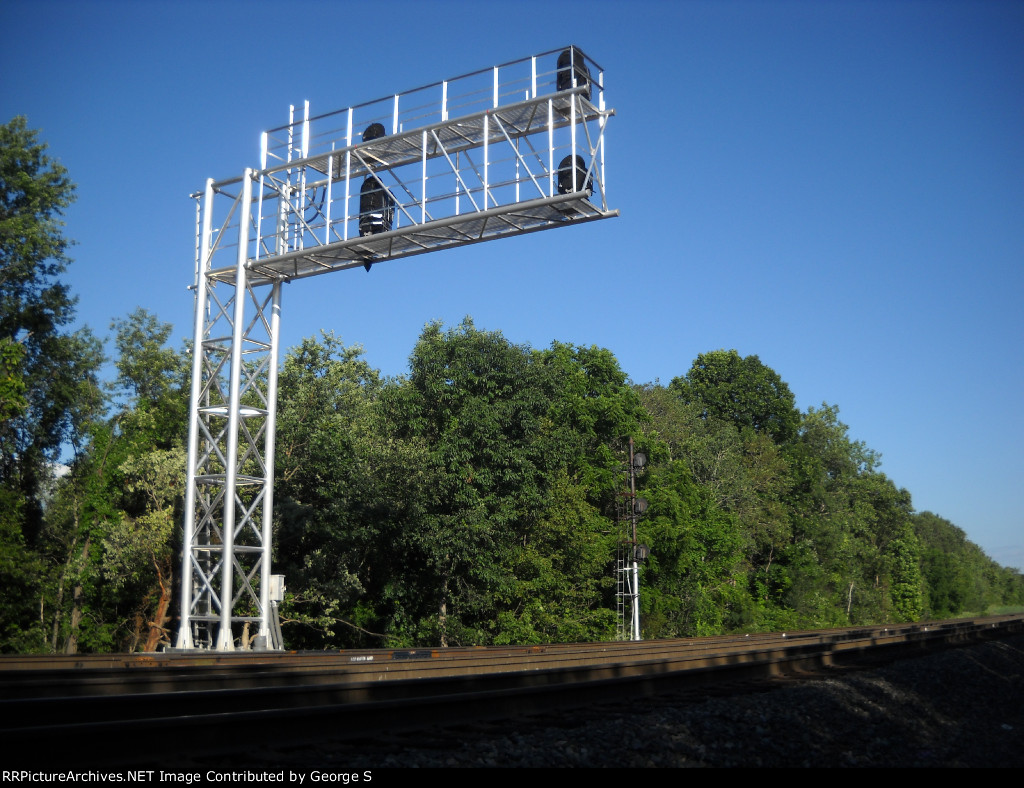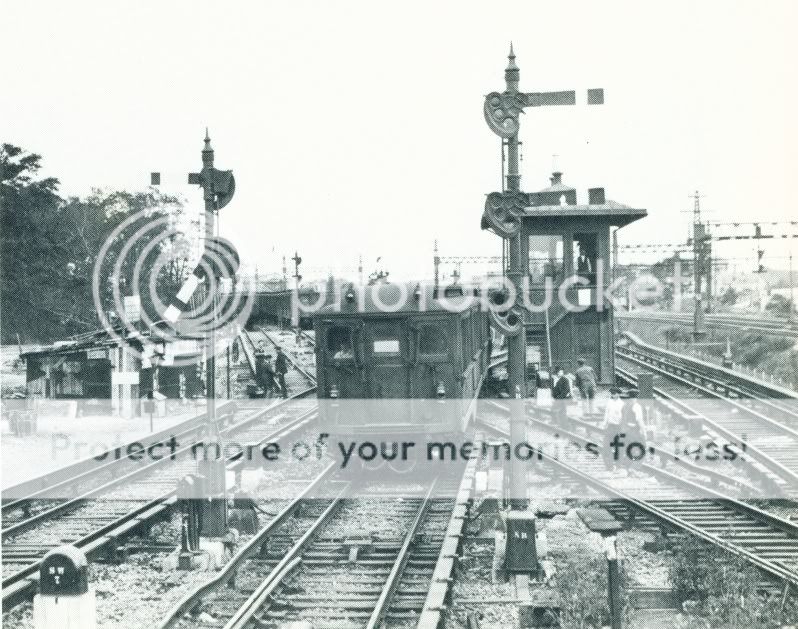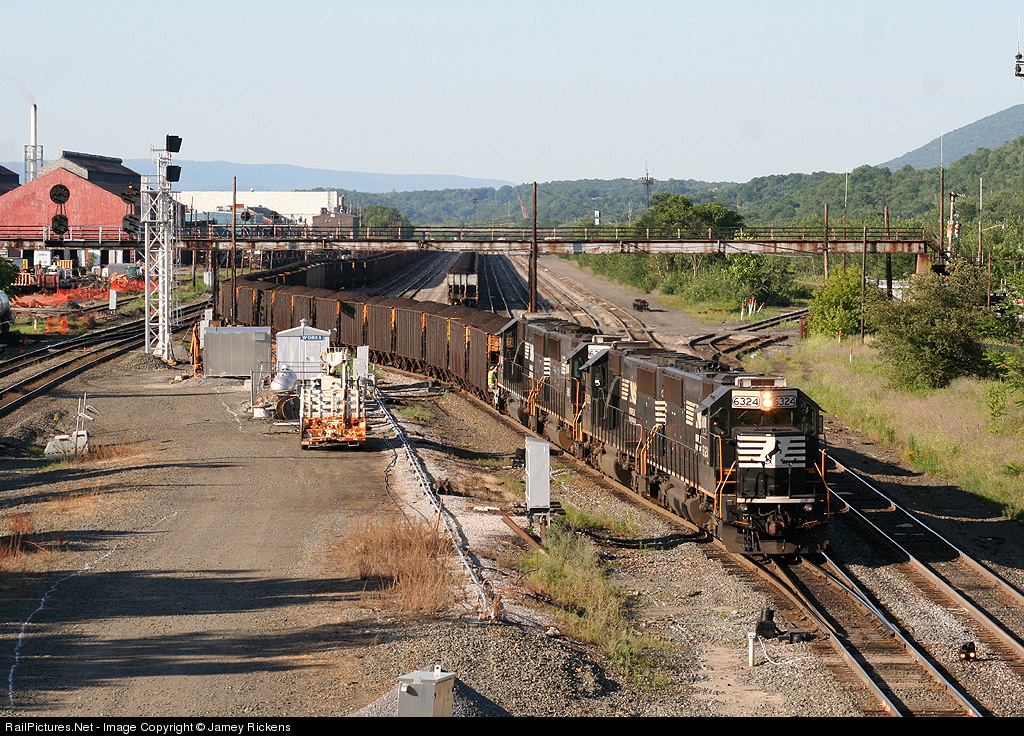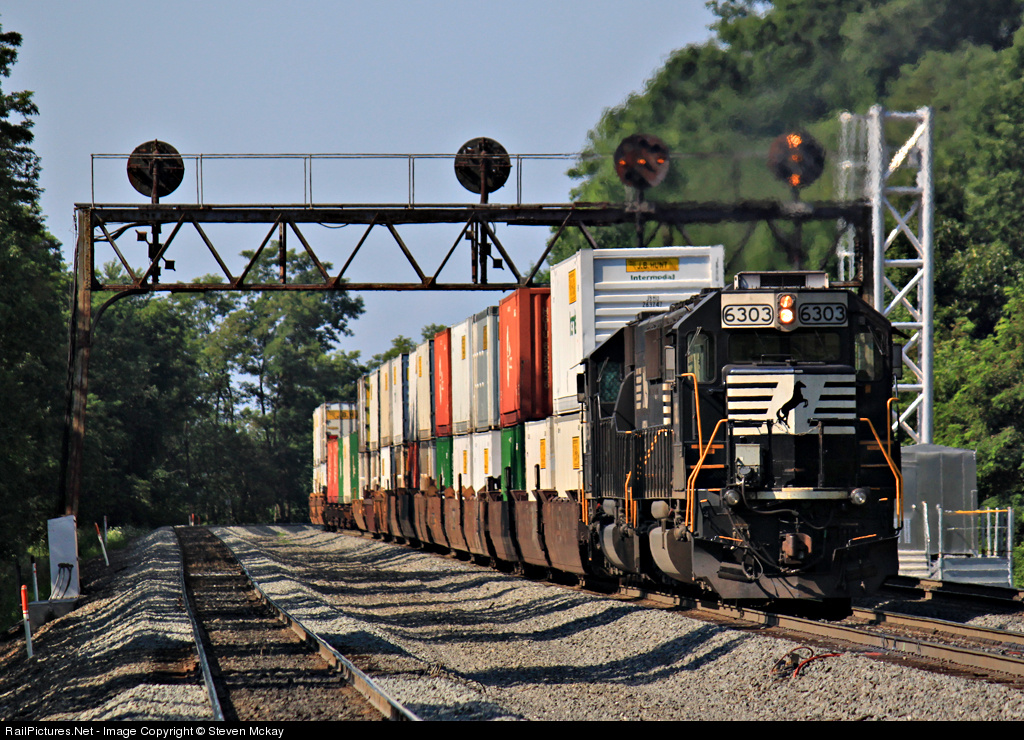Perhaps the oddest semaphore signals ever see in North America were
those in the New Haven Railroads electrified district. 3-position
electrically driven semaphores were mounted on the overhead
electrification cross supports. Due to the complexity of the catenary
obstructing the view of any signal mounted above the gantries, they were
suspended down between the tracks with a stub semaphore blade as to not
obstruct the loading gauge. The motors for the blades were mounted on
top of the gantries and drove the blades via long connecting rods
All of these signals which had not been converted to US&S H-5
searchlights were removed in the early 1990's and replaced with nothing
as Metro North went to an all cab signaling based system. I bring this
up because some wonderful person posted a mess of photos of
these signals, something I have never seen before, so I have decided to give them some exposure here.
Our first batch of suspended semaphores have the rounded end, normally used for Train Order signals, but in this case I am not sure of of its significance, although from context I can assume it is a type of absolute signal. These signals were installed in a 2+2 ABS 251 configuration and we can see come bagged H-5 units for the coming 261 operation on all 4 tracks. Also note the H-5 on the read of the closest semaphore.
Here is a closeup of that nearest signal this time displaying an Approach Medium (Y/G) indication. The New Haven RR used Y/Y for Advance Approach instead of either Y/G or *Y*.
A blog devoted to explaining the ins and outs of North American railroad signaling, past, present and future. This blog seeks to preserve through photo documentation the great diversity and technical ingenuity of 20th century signaling and interlocking hardware and technology. Related topics cover interlocking towers and railroad communications infrastructure.
Note, due to a web hosting failure some of the photos and links may be unavailable.
Search This Blog
Sunday, July 24, 2011
Wednesday, July 20, 2011
Next to Fall CP-FB
As if the Selkirk Branch hadn't been hit hard enough. This short section of double track main line built by the New York Central as part of their Albany improvement project in the 1920's played host to a fine collection of NYC and Conrail era small target GRA model SA searchlight signals. Unfortunately since 2004 the short CSX owned line has lost almost all of this heritage due to "capacity expansion" projects that saw the searchlights removed between the distant of CP-SH and the distant to CP-FB inclusive. This included the old CP-VO which saw its diamond removed around 2000, but hung in there with a set of hand throw crossovers only to be later converted into a power crossover around 2007.
Anyway, despite all this the western throat to Selkirk Yard soldiered on with NYC era searchlights at CP-FB. Unfortunately I discovered in my daily rounds that these too will soon be falling and worse still CSX will be importing its bullshit Seaboard lunar white Restricting aspect instead of using bottom yellow as is proper in the NORAC zone. What's next, R/Y for Medium Approach? Let's hope that CSX can keep its mits off CP-RJ and the classic NYC cantilever distant to CP-169.
Anyway, despite all this the western throat to Selkirk Yard soldiered on with NYC era searchlights at CP-FB. Unfortunately I discovered in my daily rounds that these too will soon be falling and worse still CSX will be importing its bullshit Seaboard lunar white Restricting aspect instead of using bottom yellow as is proper in the NORAC zone. What's next, R/Y for Medium Approach? Let's hope that CSX can keep its mits off CP-RJ and the classic NYC cantilever distant to CP-169.
Monday, July 18, 2011
RIP East 180TH ST Tower
I have just become aware that the last Main Line interlocking tower on the entire IRT located at East 180th St on the White Plains Road Line has been closed and demolished. Built in 1912, E180th St tower stood for 99 years at what became the junction of the Dyre Ave Line shuttling trains in and out of the three track station and E18th St Yard.
E180th St 2011
E180th St 1912
While all the other single interlocking towers on the IRT were closed in the 1950's and 60's to make way for extensive "Panel" type Master Towers, E180th St had survived due in part to its complexity and late model 79 lever US&S Model 14 machine,which would have been much newer than the original IRT signaling.
Later being assigned a US&S UR style NX machine for the Dyre Line, E180th St only lost its semaphore signals in the early 1970's and later the interlocking became the final holdout for the old style IRT route signaling where each complete signal head represented a route. This resulted in such unique signal indications asR/G/R and G/R for nearly a decade after it had vanished on all other parts of the NYC Subway.
E180th St 2011
While all the other single interlocking towers on the IRT were closed in the 1950's and 60's to make way for extensive "Panel" type Master Towers, E180th St had survived due in part to its complexity and late model 79 lever US&S Model 14 machine,which would have been much newer than the original IRT signaling.
Later being assigned a US&S UR style NX machine for the Dyre Line, E180th St only lost its semaphore signals in the early 1970's and later the interlocking became the final holdout for the old style IRT route signaling where each complete signal head represented a route. This resulted in such unique signal indications as
Sunday, July 17, 2011
Bad News At CP-WORKS
The first blow to the solid block of PRR PLs has been struck at CP-WORKS. The eastbound cantilever mast which dated from the Penn Central era is under threat from a new Darth Vader type cantilever. Unsure at this time is if the CP-WORKS is to be completely re-interlocked or if this is just a structural integrity issue with the cantilever. The two-track PRR era signal gantry, the pneumatic point machines and PL dwarfs all appear to be safe, but a new relay box is on site.
It is very surprising that the 1970's era tubular steel cantilever would go before the lattice gantry. I guess there is some problem with the build quality that had it targeted for removal.
It is very surprising that the 1970's era tubular steel cantilever would go before the lattice gantry. I guess there is some problem with the build quality that had it targeted for removal.
Wednesday, July 13, 2011
Deathwatch MP 238 PRR Signal Bridge
Found this photo on Railpictures.net. If anyone is out near Altoona, try to take a full survey of this signaling location if you can. It is road adjacent.
Saturday, July 9, 2011
PRR Main Line Survey 2009 Part 5 (CP-HARRIS to CP-LONG)
I hope people are getting something out of this because it's non trivial to write these posts. Anyway, so far we have explored the Amtrak portion of the old PRR Main Line. Part of that is still signaled as it was back in PRR times with manned interlocking towers and a paper dispatcher. Now we move onto the portion of the line that is owned by a private freight company. This was originally Conrail and later became Norfolk Southern after a merger in the late 1990's. Since Conrail began the PRR Main Line has been known as the Pittsburgh Line as it runs from Harrisburg to Pittsburgh. The portion of the line that comprised the old PRR Middle Division between Harrisburg and Altoona was re-signaled in the late 1980's when the old PRR block towers were finally retired. This essay will hopefully provide some insight on modern freight railroad CTC signaling on a multi track main line.
If you are interested in viewing the entire set of photos for this part you may find them here.
We begin our journey as our train leaves Amtrak property at CP-HARRIS and you may follow along with this diagram. More detailed Conrail interlocking charts of the former Conrail Philadelphia division interlockings can be found here (25MB pdf)
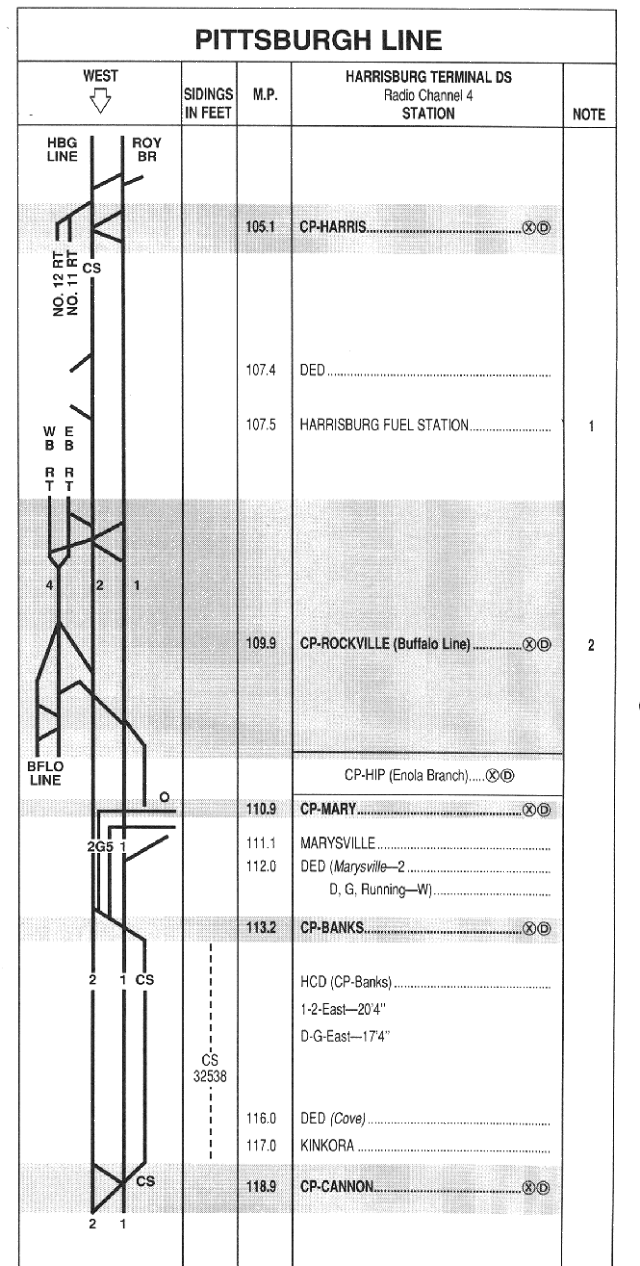
Up until about 1990 CP-HARRIS was actually an Amtrak interlocking controlled by HARRIS tower (which is now a museum). This was a holdover from the time when freight trains running on the east side of the Susquehanna came up from the electrified main to the south through the Harrisburg station and then westward to Pittsburgh. After Conrail dumped electrified operations around 1981 it began to shift its New York terminal freight traffic to the Reading/Lehigh Valley route via Reading, PA. The route was not only faster it avoided having to deal with Amtrak notoriously high trackage rates.
As a result HARRIS interlocking was in a somewhat awkward position being operated by Amtrak and optimized for "PRR" route traffic. Around 1990 Conrail implemented a project to take over control of HARRIS and re-align the routings to better connect with the former Reading Lebanon Valley branch, now known as the Harrisburg Line, and also eliminate all of the redundant yard trackage formerly used for electric to diesel power changes. Here we can see the NS Harrisburg Line taking the straight route, while the single connecting track to the Amtrak station branches off to the right. The millage here picks up from from Amtrak and we are 105 miles from Suburban Station, Philadelphia.
The signals are small target searchlights that were originally popular on the New York Central subsidiary Michigan Central. These were briefly the standard signals on the Conrail system before the switch to round target colour lights. CP-HARRIS was re-signaled in the window between when PRR Position Lights stopped being installed and colour lights came into vogue. Here we see an old overhead catenary support being jury rigged into a signal gantry supporting three, three headed searchlights. The slow speed (15mph) bottom head is used for the Amtrak connection. This is currently used by only 2 trains per day as the Chicago through train on this route was eliminated in 2005.
Our first block signal is the MP 107 automatic mid way between CP-HARRIS and CP-ROCKVILLE so it is distant to both. When Conrail re-signaled in the late 1980's it modified the PRR numbering procedure. Signals were no longer uniformly numbered on all tracks to the nearest 10th of a mile, even eastbound and odd westbound. Instead the signals were numbered to the whole mile and suffixed with the track number and direction. So the 1071E signal is Mp 107, #1 track, east direction.
Both these signals have lower heads with both | and / indications in both directions as CP-HARRIS and CP-ROCKVILLE have slow speed moves that require Approach Slow ( / over / ). Signal 1072E/W is Safetran equipment and looks newer than 1071E/W, although I don't have any further information about this. Note the MP 107 Harrisburg Dragging Equipment Detector is located immediately west of the signals. This is cab signaled territory, but wayside signals are in place throughout.
If you are interested in viewing the entire set of photos for this part you may find them here.
We begin our journey as our train leaves Amtrak property at CP-HARRIS and you may follow along with this diagram. More detailed Conrail interlocking charts of the former Conrail Philadelphia division interlockings can be found here (25MB pdf)

Up until about 1990 CP-HARRIS was actually an Amtrak interlocking controlled by HARRIS tower (which is now a museum). This was a holdover from the time when freight trains running on the east side of the Susquehanna came up from the electrified main to the south through the Harrisburg station and then westward to Pittsburgh. After Conrail dumped electrified operations around 1981 it began to shift its New York terminal freight traffic to the Reading/Lehigh Valley route via Reading, PA. The route was not only faster it avoided having to deal with Amtrak notoriously high trackage rates.
As a result HARRIS interlocking was in a somewhat awkward position being operated by Amtrak and optimized for "PRR" route traffic. Around 1990 Conrail implemented a project to take over control of HARRIS and re-align the routings to better connect with the former Reading Lebanon Valley branch, now known as the Harrisburg Line, and also eliminate all of the redundant yard trackage formerly used for electric to diesel power changes. Here we can see the NS Harrisburg Line taking the straight route, while the single connecting track to the Amtrak station branches off to the right. The millage here picks up from from Amtrak and we are 105 miles from Suburban Station, Philadelphia.
The signals are small target searchlights that were originally popular on the New York Central subsidiary Michigan Central. These were briefly the standard signals on the Conrail system before the switch to round target colour lights. CP-HARRIS was re-signaled in the window between when PRR Position Lights stopped being installed and colour lights came into vogue. Here we see an old overhead catenary support being jury rigged into a signal gantry supporting three, three headed searchlights. The slow speed (15mph) bottom head is used for the Amtrak connection. This is currently used by only 2 trains per day as the Chicago through train on this route was eliminated in 2005.
Our first block signal is the MP 107 automatic mid way between CP-HARRIS and CP-ROCKVILLE so it is distant to both. When Conrail re-signaled in the late 1980's it modified the PRR numbering procedure. Signals were no longer uniformly numbered on all tracks to the nearest 10th of a mile, even eastbound and odd westbound. Instead the signals were numbered to the whole mile and suffixed with the track number and direction. So the 1071E signal is Mp 107, #1 track, east direction.
Both these signals have lower heads with both | and / indications in both directions as CP-HARRIS and CP-ROCKVILLE have slow speed moves that require Approach Slow ( / over / ). Signal 1072E/W is Safetran equipment and looks newer than 1071E/W, although I don't have any further information about this. Note the MP 107 Harrisburg Dragging Equipment Detector is located immediately west of the signals. This is cab signaled territory, but wayside signals are in place throughout.
Subscribe to:
Posts (Atom)


